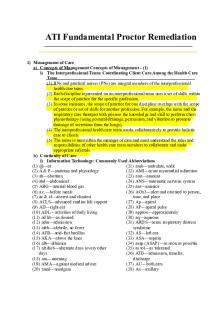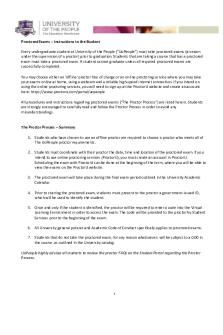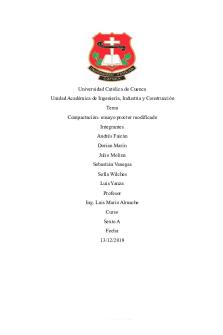ATI- OB Proctor Remediations PDF

| Title | ATI- OB Proctor Remediations |
|---|---|
| Author | Myrna Pinnock |
| Course | Life Span Development |
| Institution | Palm Beach Atlantic University |
| Pages | 3 |
| File Size | 116.1 KB |
| File Type | |
| Total Downloads | 93 |
| Total Views | 153 |
Summary
lecture...
Description
Myrna Pinnock NSG3047
ATI: RN Maternal Newborn Online Proctor Remediations
Medical Conditions: Priority Finding That Requires Further Assessment 1. Cervical insufficiency is a painless opening of the cervix that results in delivery of the baby in the 2nd trimester of pregnancy. Some expected findings are pink stained vaginal discharge or bleeding, possible gush of fluid, and uterine contractions w/ expulsion of fetus. 2. The nurse needs to evaluate the client’s support system and if assistance is available for them if they are prescribed activity restrictions or bed rest. 3. Assess the client for any vaginal discharge, monitor client reports of pressure and contractions, and check vital signs.
Nursing Care of Newborns: Performing Suctioning with a Bulb Syringe 1. Routine suctioning of the mouth and nasal cavity is common with newborns suction mouth first then nose this is done to remove excess mucus from the respiratory tract by 2. first compressing the bulb 3. Insertion into one side of the mouth, avoiding the center of the mouth because of the gag reflex, Aspirate mouth first, then one nostril and then the other nostril.
Assessment and Management of Newborn Complications: Priority Finding that Requires Further Assessment 1. Signs of alcohol withdrawal include jitteriness. Irritability, increased tones and reflex responses, and seizures. A term newborn’s blood glucose should be 30-60mg/dL. Hypoglycemia can bring about poor feeding, jitteriness/tremors, hypothermia, diaphoresis, weak cry, and lethargy. 2. Other reportable findings are respiratory distress which include tachypnea, nasal flaring, expiratory grunting, retractions, and cyanosis. Newborn infections like sepsis can cause an infant to have temperature instability, suspicious drainage, poor feeding, weak suck, vomiting, diarrhea, hypo or hyperglycemia, respiratory distress, and low BP. 3. Hyperbilirubinemia includes yellowish tint to skin, sclera, mucous membranes, observe the newborns color for yellowish tint as the skin is blanched, and assess if there is an underlying cause that needs to be fixed. Look for hypoxia, hypothermia, hypoglycemia, and metabolic acidosis. Increased risk for brain damage. Congenital anomalies involve cleft lip/palate and tracheoesophageal fistula, excessive mucous secretions and drooling, periodic cyanotic episodes and choking,
Assessment and Management of Newborn Complications: Caring for a Newborn Who Has Abstinence Syndrome 1. Neonatal abstinence syndrome is what happens when babies are exposed to drugs in the womb before birth. Babies can then go through drug withdrawal after birth. The syndrome most often applies to opioid medicines. 2. Monitor newborn's ability to feed and digest intake, offer small frequent feedings, swaddle newborn with legs flexed, looser than normal, reduce environmental stimuli (lights off, lower noise level), and educate the mom on SIDS prevention strategies 3. When caring for a newborn with neonatal abstinence syndrome, monitor newborn's ability to feed and digest intake, offer small frequent feedings, swaddle newborn with legs flexed, looser than normal, reduce environmental stimuli (lights off, lower noise level), and educate mom on SIDS prevention strategies. Assessment of Fetal Well-Being: Complications Associated with an Amniocentesis 1. Amniocentesis is when amniotic fluid is aspirated to analyze the location of the placenta and the fetus’s location. This is performed after 14 weeks of gestation. 2. Some complications with an amniocentesis include amniotic fluid emboli, maternal or fetal hemorrhage, fetomaternal hemorrhage with Rh isoimmunization, maternal or fetal infection, inadvertent fetal damage. 3. Anomalies involving limbs, fetal death, inadvertent maternal intestinal or bladder damage, miscarriage or preterm labor, premature rupture of membranes, and leakage of amniotic fluid.
Therapeutic Procedures to Assist with Labor and Delivery: Labor Induction Using Oxytocin 1. Some methods to induce labor are prostaglandins applied cervically, the administration of IV oxytocin (Pitocin), amniotomy or stripping of membranes, and nipple stimulation to trigger the release of endogenous oxytocin. 2. Before administering oxytocin, the nurse must confirm that the fetus is engaged in the birth canal at a minimum of station 0. Oxytocin should be connected "piggyback" to the primary IV line and administered via an infusion pump. When administering oxytocin, check the maternal blood pressure, pulse, and respirations every 30 min and every dose change 3. The nurse should monitor FHR and contraction pattern every 15 min and with every change in dose, assess fluid intake and urinary output, and obtain a Bishop score rating before starting any labor induction protocol Infections: Planning Care for a Client Who Has HIV 1. Infant should be bathed after birth before remaining with the mother. 2. Instruct the client not to breastfeed. 3. Procedures such as amniocentesis and episiotomy should be avoided due to the risk of maternal blood exposure.
4. Use of internal fetal monitors, vacuum extraction, and forceps during labor should be avoided due to the risk of fetal bleeding. 5. Administration of injections and blood testing should not take place until the first bath is given to the newborn.
Fetal Assessment During Labor: Nursing Action for Late Decelerations 1. Causes and complications for the late deceleration of FHR are slowing FHR after the contraction has started with a return to baseline well after the contraction has ended. Uteroplacental insufficiency causing inadequate fetal oxygenation. 2. Maternal hypotension, abruptio placentae, uterine hyperstimulation with oxytocin (Pitocin). Place the client in a side-lying position and increase the rate of IV fluid administration. Discontinue oxytocin (Pitocin) and administer oxygen by mask at 8 to 10 L/min. 3. The provider needs to be notified and prepare for an assisted vaginal birth or cesarean birth. . Assessment and Management of Newborn Complications: Actions to Take for a Newborn Receiving Phototherapy 1. Phototherapy is a procedure when UV light is used to facilitate the conversion of unconjugated bilirubin in the newborn to its conjugated form so it can be excreted through fecal matter via bile. 2. Hyperbilirubinemia is when the total serum bilirubin level is above 5mg/dL. This results from unconjugated bilirubin being deposited in the skin and mucous membranes. Phototherapy should be used if or when the levels of unconjugated serum bilirubin increase and do not return to normal levels with increased hydration. 3. Place an eye mask over the newborns eyes after they are gently closed to protect the corneas and retinas. The nurse should know to avoid applying lotions or ointments to newborns because they absorb heat and can cause burns. Turn off phototherapy lights before drawing blood for testing and remove the newborn every two hours to expose all of the body surfaces to the phototherapy lights and prevent pressure sores....
Similar Free PDFs

ATI- OB Proctor Remediations
- 3 Pages

Virtual ATI Remediations
- 4 Pages

ATI Proctor Fund Remediation
- 25 Pages

Ati med surg quiz - ati proctor
- 4 Pages

ATI Proctor RN Pharmacology 2019
- 3 Pages

OB maternalnewborn ati notes
- 21 Pages

ATI notes OB
- 8 Pages

ATI OB Study guide pdf
- 26 Pages

ATI-OB-P2 2 - Template
- 1 Pages

Proctor-Instructions
- 3 Pages

Compactacion proctor
- 9 Pages

ATI Detail Answer Key NURS 306 OB
- 119 Pages
Popular Institutions
- Tinajero National High School - Annex
- Politeknik Caltex Riau
- Yokohama City University
- SGT University
- University of Al-Qadisiyah
- Divine Word College of Vigan
- Techniek College Rotterdam
- Universidade de Santiago
- Universiti Teknologi MARA Cawangan Johor Kampus Pasir Gudang
- Poltekkes Kemenkes Yogyakarta
- Baguio City National High School
- Colegio san marcos
- preparatoria uno
- Centro de Bachillerato Tecnológico Industrial y de Servicios No. 107
- Dalian Maritime University
- Quang Trung Secondary School
- Colegio Tecnológico en Informática
- Corporación Regional de Educación Superior
- Grupo CEDVA
- Dar Al Uloom University
- Centro de Estudios Preuniversitarios de la Universidad Nacional de Ingeniería
- 上智大学
- Aakash International School, Nuna Majara
- San Felipe Neri Catholic School
- Kang Chiao International School - New Taipei City
- Misamis Occidental National High School
- Institución Educativa Escuela Normal Juan Ladrilleros
- Kolehiyo ng Pantukan
- Batanes State College
- Instituto Continental
- Sekolah Menengah Kejuruan Kesehatan Kaltara (Tarakan)
- Colegio de La Inmaculada Concepcion - Cebu



